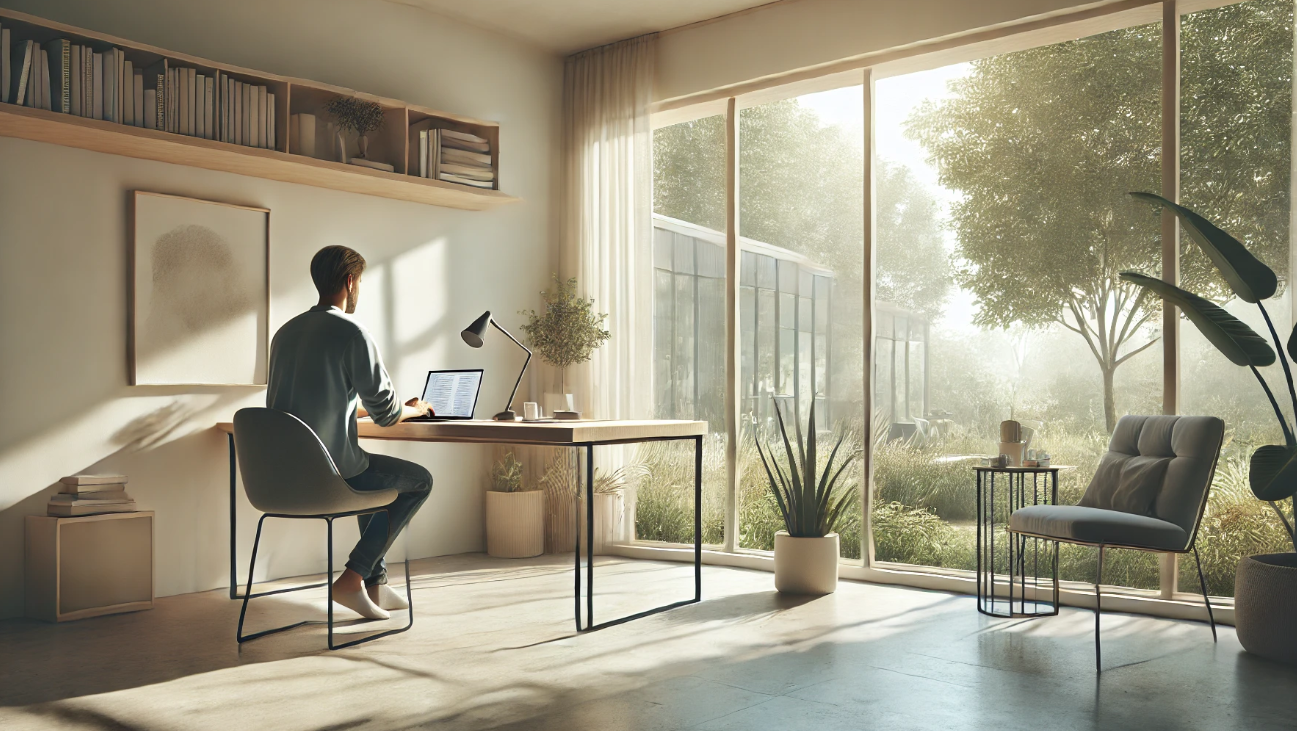In a world where even goldfish have longer attention spans than humans (we’re talking eight seconds versus nine), staying focused on writing can feel like trying to meditate in the middle of a rock concert. Between pinging notifications, noisy neighbors, and the irresistible call of social media, distractions are not just abundant—they’re relentless. According to research from Udemy, 70% of workers admit to feeling distracted during the workday, with 16% saying they’re always distracted. Your writing environment is no exception.
But imagine your writing space as a serene bubble of creativity—a fortress for your thoughts, where the outside world can’t break in. This isn’t just about comfort; it’s about entering a state of flow, the ultimate writing zone where ideas flow like water from a mountain stream and words land on the page with ease. With fewer distractions, your writing can transform from a scattered jumble of thoughts into a symphony of well-crafted prose. So, crafting your own distraction-free writing environment isn’t just helpful—it’s an essential tool for success in a world that’s always competing for your attention.
The Writing Journey and Its Challenges
Writing is a journey from idea conception to the final draft. It typically involves brainstorming, outlining, drafting, revising, and editing. Each stage demands focus and creativity, making the environment in which one writes crucial to success. Writers often face challenges such as writer’s block, procrastination, and self-doubt.
Your Publishing Journey Awaits – Start NowThese hurdles can be exacerbated by distractions like social media, household chores, or noisy surroundings. Distractions not only disrupt the flow of thoughts but also break the writing routine and schedule, leading to missed deadlines and unfinished projects. Maintaining a distraction-free environment helps writers stay on track, keep their thoughts coherent, and efficiently move through the stages of the process, ultimately producing higher-quality work.
Where is the Ideal Writing Environment?
Creating the ideal writing environment is a blend of art and science. It’s a space tailored to inspire creativity while fostering focus and comfort. At its core, an ideal writing environment is one where distractions are minimized, and the mind is free to wander through the realms of imagination.
Lighting is a critical element. Natural light is best, as it reduces eye strain and enhances mood, but if that’s not an option, a well-placed lamp with warm light can work wonders. Comfortable furniture, particularly a supportive chair and a spacious desk, is essential. These pieces reduce physical fatigue, allowing you to write for extended periods without discomfort.
Noise levels can make or break your concentration. Some writers thrive in complete silence, while others find inspiration in the subtle hum of a coffee shop or the soft strains of background music. Experiment to find what best supports your focus.
Additionally, personal touches like inspiring artwork, a few plants, or meaningful trinkets can make the space feel uniquely yours, promoting a sense of comfort and ownership. Ergonomic setups help reduce eye strain and physical fatigue, making your writing sessions more productive and enjoyable. By tailoring these elements to your preferences, you create the perfect writing environment for you where creativity flows effortlessly, and writing becomes a joy.
Your Writing Sanctuary
Creating the perfect writing environment is key to unlocking your creative potential and making sure you are getting actual writing done!
Start by tailoring the space to suit your needs and preferences. This could mean adding a favorite chair, adjusting the lighting, or incorporating inspiring decor.
Ambiance plays a significant role in maintaining focus. For some, soft background music or the gentle hum of a coffee shop soundtrack can enhance concentration. Experiment with different genres and volumes to find what works best for you. Similarly, scents can influence your mood and productivity. Consider using essential oils or scented candles with invigorating fragrances like peppermint or calming ones like lavender.
Minimizing distractions is crucial. Keep your phone on silent or in another room, and set boundaries with household members during your writing time. Using apps or tools that block distracting websites can also help maintain focus.
Setting Up Your Writing Space
Finding out what works for you makes huge difference. Here are some practical tips to help you set up a writing environment that maximizes your productivity and creativity.
1. Home Office: A dedicated home office can be an ideal writing space. Choose a quiet room with good lighting and minimal distractions. Invest in a comfortable chair and a desk that fits your needs. Keep your workspace organized with shelves and drawers for your writing supplies. Personalize the space with items that inspire you, such as photos, artwork, or plants.
2. Coffee Shop: Many writers find inspiration in the bustling atmosphere of a coffee shop. The ambient noise and change of scenery can stimulate creativity. Or even just a new environment can help your mind get its creative juices flowing. Choose a spot with a comfortable seat and a table that accommodates your laptop or notebook. Bring essential supplies like noise-canceling headphones, a notebook, and pens to stay organized.
3. Library: Libraries offer a quiet and focused environment, perfect for writing. Find a secluded corner or reserve a study room if available. Libraries also provide access to a wealth of research materials that can be invaluable for your writing process. Bring along your laptop, charger, and any other writing supplies you need.
4. Writing Supplies and Organization: Keep your writing space stocked with essential supplies like notebooks, pens, highlighters, sticky notes, and reference books. Use organizers and storage solutions to keep your desk clutter-free. A whiteboard or corkboard can help you keep track of ideas, deadlines, and writing goals.
By setting up a writing space that suits your needs and preferences, you create an environment that encourages focus, minimizes distractions, and supports your writing endeavors.
Developing a Writing Routine and Schedule
Turn your writing from a sporadic activity into a productive habit by developing the best routine for you. Establishing a regular schedule helps condition your mind to focus during designated times, making it easier to get into the flow of writing.
Your Publishing Journey Awaits – Start NowTo create an effective writing schedule, start by identifying the times of day when you feel most creative and alert.Allocate these peak hours for your writing session. Set realistic goals, such as writing for 30 minutes each day or completing a certain word count. Use tools like calendars or planners to block out this time and treat it as a non-negotiable appointment.
Regular writing has numerous benefits. It boosts productivity, as consistent practice hones your skills and speeds up your workflow. It also helps in completing projects faster, as daily progress accumulates significantly over time. Additionally, a steady routine reduces the pressure of last-minute deadlines, making the writing process more enjoyable and less stressful.
5 Tips to Stay Focused During Writing Sessions
By incorporating the following tips and techniques, you can keep concentration flowing, boost productivity, and make the most of your time.
- Timed Writing Sessions
- Use the Pomodoro Technique: write for 25 minutes, then take a 5-minute break.
- Keeps your mind fresh and reduces burnout.
- Regular Breaks
- Step away from your desk, stretch, or take a short walk.
- Helps recharge and maintain energy levels.
- Focus Tools
- Use apps to block distracting websites.
- Utilize ambient noise generators to create a conducive space.
- Set Clear Goals:
- Define what you aim to achieve in each session.
- Helps maintain direction and purpose.
- Minimize Distractions:
- Turn off phone notifications or place your phone in another room.
- Create a quiet, clutter-free workspace.
Finding Inspiration in Your Writing Environment
A well-designed writing space can be a powerful source of inspiration. The right environment can ignite creativity and fuel your writing. For instance, some writers find inspiration in minimalist setups that keep distractions at bay, while others thrive in spaces filled with books, art, and personal mementos.
Published authors often create environments tailored to their needs. Stephen King writes in a room with closed doors to shut out distractions, while Maya Angelou preferred writing in bare hotel rooms to maintain focus. By designing a space that resonates with you, filled with elements that spark joy and creativity, you can find endless inspiration right at your desk.
Now You Can Craft Your Creative Haven
Creating a distraction-free writing environment is essential for boosting productivity and unleashing your creative potential. Key points include understanding the importance of a well-designed space, personalizing it to suit your needs, and establishing a consistent writing routine. By minimizing distractions and finding inspiration in your surroundings, you can enhance your focus and make writing an enjoyable, efficient process.
Apply these tips to craft your ideal writing space, one that nurtures your creativity and supports your writing goals. Your perfect environment awaits—transform your space and watch your productivity soar and you’ll start writing straight away!
Your Publishing Journey Awaits – Start Now






